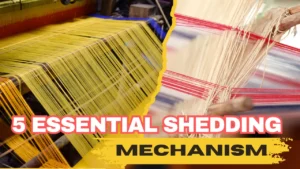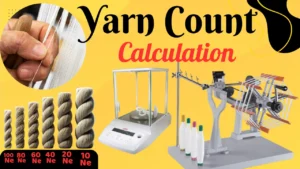Shedding:
Shedding is the first primary motion of weaving. First of all separation of warp threads into two parts for insertion of weft threads is called Shed and the mechanism of forming shed is called Shedding.
Shedding is the mechanism of dividing the warp threads according to design into two parts, to allow the passage of shuttle / weft inserting element from one side of the loom to the other side.
What is SHED?
When the warp threads are separated in the operation of weaving is called SHED. In another words, separation of warp sheet into two parts for inserting weft is called SHED.

Different Types of SHED:
Usually, there are two types of SHED. They are-
1. Open Shed (O.S): Open Shed can be divided into two types.
- Fully Open Shed
- Semi Open Shed
2. Close Shed (C.S): Close Shed can be divided into two types.
- Bottom Close Shed
- Centre Close Shed
1. Open Shed:
The shed is always in the open position in this type of shed.
Fully-open Shed:
In this type of shed, the warp threads form two stationary lines, one at the top and the other at the bottom. After inserting a pick, changes are made by carrying threads from one fixed line to the other, so some threads are lowered from the top line and some threads are raised from the bottom line. During this change, the raising and lowering of threads occur simultaneously. Therefore, the shed is formed in a minimum period of time. As the falling threads help the rising threads to move, strain upon the warp yarn is low.

Figure Shows a fully-open shed. In the figure, A and B are the stationary bottom and top lines respectively. The arrows C and D show the movements of the falling and rising threads respectively. Full lines show that the shed is always in an open position only. So this shed is known as fully-open shed.
Merits of Fully-open Shed:
- Rising threads help to move lowering threads.
- Strain upon the warp is low, so it requires a minimum period of time to form a shed.
- The loom can run at a high speed.
- Power consumption is low.
- Wear and tear of the loom parts is low.
Demerits of Fully-open Shed:
- This type of shedding is troublesome to weavers because the two fixed lines make it more difficult to repair broken ends. Therefore a leveling mechanism is added to all looms using this type of shedding mechanism. While repairing broken ends, this leveling mechanism is brought into operation.
- As the shed is always open, breakages may results especially when the yarn is weak.
- When many Heald shafts are used, the strain on the warp yarns in the back Heald shafts is increased and hence warp breakages may occur.
Uses of Fully-open Shed:
- Plain loom for producing twill and satin weaves.
- In double-lift dobby loom.
Semi-open Shed:
This is formed under both closed and open principles. In this shed, a stationary bottom line is retained. The top line is a movable one. After inserting a pick, the top line moves towards the bottom line. When the threads are moving down, some of the threads which are to form once again at the top line are arrested midway and are then carried to the top line. The remaining threads move down. Similarly, the threads which are to be at the top line also move up and are carried to the top line.

Figure shows a semi-open shed. In the figure, A is the bottom stationary line. B is the top line. Arrow D, shows the movement of rising threads from the bottom to the top line. Arrow E shows the movement of rising threads from the bottom to the top line. Arrow F shows the movement of the arrested threads at the midway position C. From the midpoint C these threads are carried to the top line. The full lines indicate the positions of shed lines after inserting a pick. They are in a semi-open state. So this type of shed is known as semi-open.
Merits of Semi-open Shed:
- In a semi-open shed, the strain upon the warp is low.
- It requires minimum time to form a shed.
- The loom can run at a high speed.
- Power consumption is low.
- Wear and tear of the loom parts is low.
Demerits of Semi-open Shed:
- This shedding is troublesome to weavers because the two fixed lines make it more difficult to repair broken ends. Therefore a leveling mechanism is added to all the looms using this type of shedding motion. While repairing broken ends, this leveling mechanism is used.
- As the shed is always open, breakages may result, especially when the yarn is weak.
- When many heald shafts are used, the strain on the warp yarn at the back heald shafts is increased and hence warp breakages may occur.
- In a fully-open shed, the strain on the rising and falling threads is equally distributed. But in a semi-open shed, since some of the threads are coming from the bottom line and some threads are arrested midway and again carried to the top, the strain is not equally distributed.
Uses of Semi-open Shed:
Many double-lift dobbies and double-lift jacquards form semi-open sheds.
2. Closed Shed:
This type of shed closes after every pick is inserted. So all the warp threads come to the same level after each pick is inserted.
Centre-Closed Shed:
In this type of shed, warp threads move in an upward and downward direction from a Centre-line. The threads which are to form the top line move upwards and the threads which are to form the bottom line move to bottom line. After inserting a pick both the lines meet at the Centre-line.

Figure shows a Centre-closed shed. A is the Centre-line. B and C are the top and bottom lines respectively. D and E are the arrows showing the movements of the rising and falling threads respectively.
Merits of Centre-Closed Shed:
- A rising thread is partially balanced by a falling thread.
- The machine can run at high speed.
- Power consumption and wear and tear of the loom parts are low.
Demerits of Centre-Closed Shed:
- Since every thread is moved to form each shed, strain on the warp is more than that for the open shed.
- An unsteady movement of threads is caused by the warp threads being in constant motion.
Uses of Centre-Closed Shed:
Centre-shed dobbies, Centre-shed jacquards and handlooms form Centre-closed sheds.
Bottom-Closed Shed:
This kind of shed is formed by giving motion to only those threads that form the top line. Under these conditions, after inserting a pick, all the warp yarns come to the bottom line.

Figure shows a bottom-closed shed. A represents the bottom stationary line, B the top line and C is the arrow showing the movement of threads.
Merits of Bottom-Closed Shed:
The alternate tightening and slackening of threads produces a cloth with good cover.
Demerits of Bottom-Closed Shed:
- It takes a long time to produce a shed, since it is necessary to move the threads a space equal to twice the depth moved in other types of sheds.
- It is unsuitable for high loom speed.
- Strain on the warp is high.
- Wear and tear of the loom parts is high.
- Power consumption of the loom is high.
Uses of Bottom-Closed Shed:
Single-lift dobbies and single-lift jacquards produce bottom-closed sheds.
Different Types of Shedding Mechanism:
According to automation:
- Paddle / Treadle shedding. (Manual, in hand loom)
- Tappet shedding.
- Dobby shedding.
- Jacquard shedding.
- Combined shedding:
- Paddle / Treadle and Jacquard.
- Tappet and Dobby.
- Dobby and Jacquard.
- Tappet and Jacquard.
- Tappet, Dobby and Jacquard.
Again according to Heald frame movement:
- Positive shedding: Lifting and lowering of Heald frame is done mechanically (by cam).
- Negative shedding: Lifting of Heald frame is done mechanically but lowering is done by dead weight or by spring.

Conditions of Good Shedding:
- The shed should be as small as the nature of the work to be done.
- Exact vertical movement of Heald frame.
- Perfect leveling of the Heald frame when the shed is either open or closed.
- The frame must begin to move slowly and towards the center of the shed move fastest.
References:
- Principles of Weaving by R. Marks, A. T. C. Robinson
- Weaving: Machines, Mechanisms, Management by Marinal Kanti Talukdar, P. K. Sriramulu, Dinkar Bapurao Ajgaonkar
To learn more on Fabric, Weaving and Loom, you can check on the following article:





6 thoughts on “5 essential shedding mechanism for weaving loom”
Great article! Easy to understand and very helpful for learning about shedding mechanisms. Thanks for sharing
Thanks Saim.
Very helpful article about mechanism.
thanks Hasan.
This is a very important article sir. It will be very helpful in studying.
Thanks Abed.